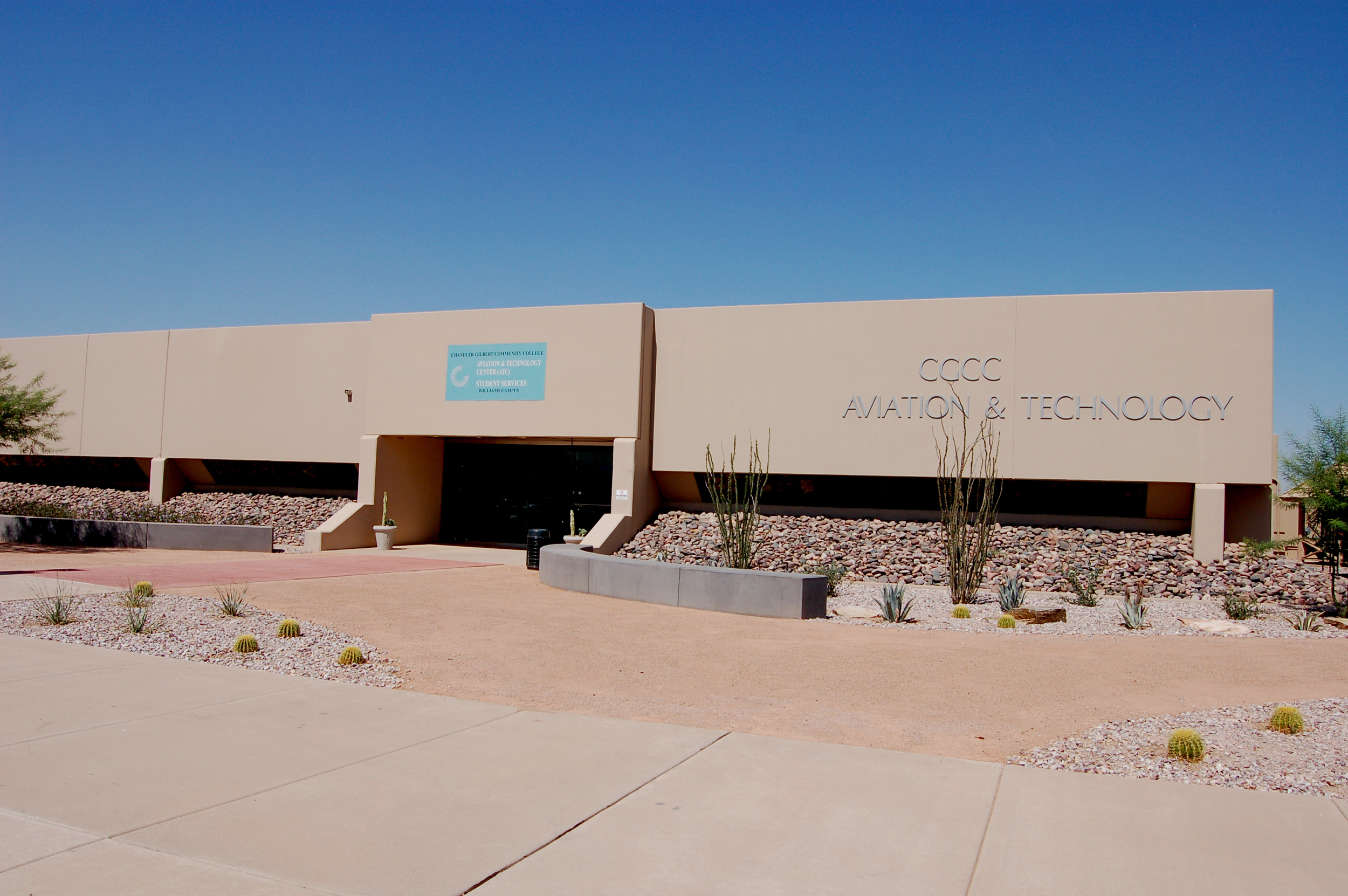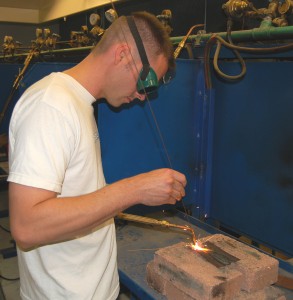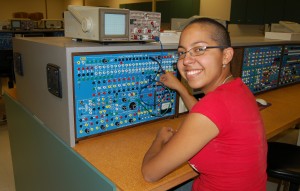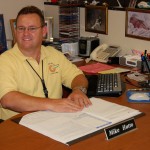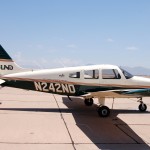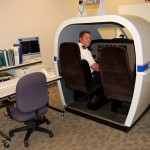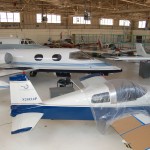By Bob Shane
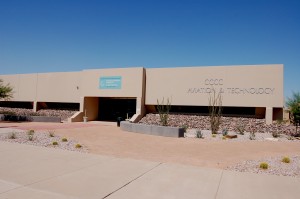
Chandler-Gilbert Community College’s Aviation & Technology Center is located at Williams Gateway Airport in Mesa, Ariz.
It’s common knowledge that Arizona, with its 330 days of sunshine a year, is a great mecca for tourists. Those same rays of sunshine have also attracted talented instructors and companies in the education business, whose skilled staffs provide training to the many students enrolled in professional aircraft maintenance and flight training programs offered by Arizona’s strong post secondary educational system.
Professional flight training can be obtained at the university and community college level, with the possibility of also getting a degree, as well as through flight schools and independent flight instruction. There are also airline pilot flight schools that primarily serve the needs of specific commercial air carriers such as British Airways, Lufthansa and Sabena. In total, there are approximately 40 such schools located throughout the state, but mostly in the Phoenix and Tucson area.
The three schools offering aircraft maintenance training designed to prepare students for licensing as certified airframe and powerplant mechanics are Chandler-Gilbert Community College in Mesa, Ariz., Cochise College in Douglas, Ariz., and Pima County Community College in Tucson.
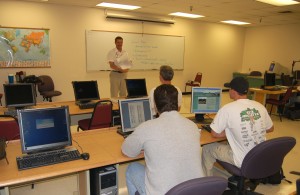
Instructor Steven Boring teaches Computer Based Training, the paperwork side of overhauling an engine.
Arizona is home to one of the nation’s largest community college systems. The Chandler-Gilbert Community College offers both a Federal Aviation Administration approved maintenance program and flight program. Its Williams campus is located at Williams Gateway Airport, the former site of Williams Air Force Base before the Department of Defense released the Base Closure and Realignment Report in April of 1991, recommending the base be closed. As an active Air Force training facility, Williams graduated more student pilots and instructors than any other base in the country, supplying 25 percent of the Air Force’s pilots annually. More than 26,500 pilots were trained at Williams.
Today, with year-round perfect flying weather, the tradition of pilot training continues at Williams Gateway Airport. Arizona State University, Chandler-Gilbert Community College, The Regional Airline Academy, Silver State Helicopters, the University of North Dakota and X-Air Inc. offer flight training programs.
The Aviation Division chairperson in charge of CGCC’s Aviation and Technology Center is Mike Hutto. Energetic and aviation savvy, Hutto brings 25 years of practical experience gathered from the military and commercial airline sectors to the job. Acutely aware of the needs of the local aerospace industry, Hutto says it’s one of his objectives to “service the community by providing quality instruction so that our students are prepared for the aviation job market.”
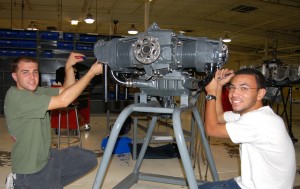
After overhauling the school’s Lycoming engine, Joel Tricomo (left) and Mark Langan are in the process of reassembling the power plant.
“The college offers the vocational training for a student to go on to fly or on to become a licensed aircraft mechanic,” he said.
In the Aviation Flight Technology Program, students are prepared to take the FAA written and practical examination for private pilot, commercial pilot (single and multi-engine), instrument rating and certified flight instructor (single engine). The University of North Dakota Aerospace Foundation provides the flight portion of this program using the single-engine Piper Warrior, high-performance Piper Arrow and multi-engine Piper Seminole. The training is designed to be a two-year program offering an Associate in Applied Science degree in airway science technology. The cost of obtaining all of these ratings is in excess of $41,000. CGCC has an articulation agreement with UND for its students to transfer to UND in Grand Forks, N.D., to complete a four-year degree. The school also has an articulation agreement with ASU.
In the Aircraft Maintenance Technology Program, students are prepared for licensing as certified A&P mechanics. The program is designed to be an 18-month course offering an AAS degree.
The college has an interesting fleet of aircraft available for the A&P students to train on. At the top of the list is a Lear Jet 23 once owned by a Libyan prince. Other aircraft include a T-39 Sabreliner, Cessna 310, Cessna 172RG, Bianca Super Viking 17-30A, AA-1A Grumman Yankee (Traveler), Piper Apache, Piper Tri-Pacer, Bell OH-58 / Bell 206, Scorpion Helicopter (experimental) and an experimental Vans RV-3.
While the Associate Degree is offered, most students in the maintenance program are mainly interested in getting the certificates awarded for satisfactorily completing the A&P parts of the training.
“These certificates are often a fast track to a high-tech job,” Hutto said.
The cost to complete the A&P program includes 67 credit hours at $65 per credit or $4,355 in tuition for a county resident. After adding books, tools, lab fees, oral and practical tests, the total is around $6,200.
In the aviation curriculum, the school has a ratio of 18 students per instructor per class. This gives each student the opportunity for more personalized instruction. The average age of a student enrolled is 27, indicating many students are seeking to make a vocational change.
In the past, there have been internships for CGCC students with companies like Honeywell. The school is always looking to set up more of these programs.
“We have had no problem finding jobs for our students that are seeking employment,” Hutto says. “The demand for newly graduated mechanics and pilots is strong. The industry is starving for entry-level personnel.”
Upon request, the school serves the community by putting together tailor-made courses for the personnel of local aerospace companies. In the past, such courses were designed for America West Airlines, Honeywell and U.S. Airways.
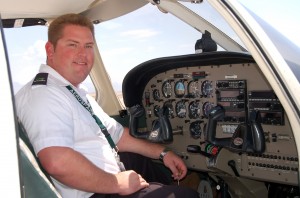
Robby Hodges, a graduate of the college’s maintenance and flight programs, is now a flight instructor for the University of North Dakota, which provides the flight training portion of CGCC’s flight curriculum.
CGCC is an example of a good affordable community college, or as the school’s ad states: “Quality education at a community college price.”
Additional aviation training programs in the Grand Canyon State will be reviewed in the September issue of Airport Journals.
Additional information on the Chandler-Gilbert Community College can be found at [http://www.cgc.edu].
- Mike Hutto is the Aviation Division chairperson who oversees the operation of the college’s Aviation & Technology Center.
- Single-engine flight training is given in the Piper Warrior.
- Single-engine flight training is given in the Piper Warrior.
- Included in the fleet of aircraft available for students to work on is a fully operational Lear Model 23.











